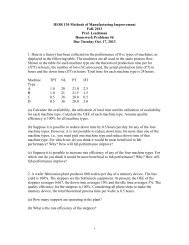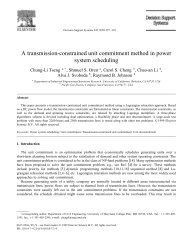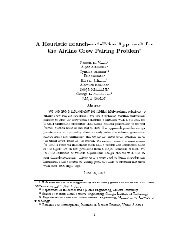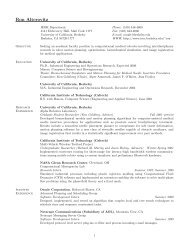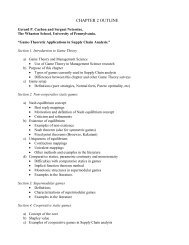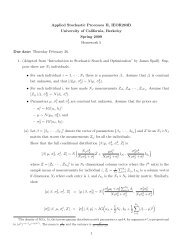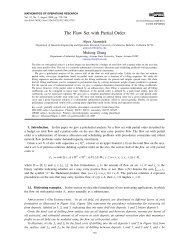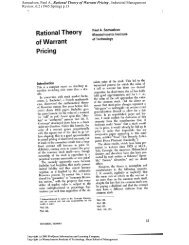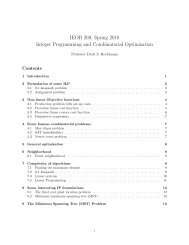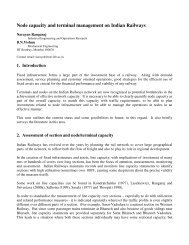Long Monotone Paths in Abstract Polytopes - University of California ...
Long Monotone Paths in Abstract Polytopes - University of California ...
Long Monotone Paths in Abstract Polytopes - University of California ...
You also want an ePaper? Increase the reach of your titles
YUMPU automatically turns print PDFs into web optimized ePapers that Google loves.
MATHEMATICS OF OPERATIONS RESEARCH<br />
Vol. 1, No. 1, February, 1976<br />
Pr<strong>in</strong>ted <strong>in</strong> U.S.A.<br />
LONG MONOTONE PATHS IN ABSTRACT<br />
POLYTOPES*<br />
I. ADLER t AND R. SAIGAL$<br />
As is now well known, the simplex method, under its various pivot<strong>in</strong>g rules, is not a "good<br />
algorithm" <strong>in</strong> the sense <strong>of</strong> J. Edmonds, i.e., the number <strong>of</strong> pivots needed to solve a given<br />
l<strong>in</strong>ear programm<strong>in</strong>g problem by this method cannot be bounded by a polynomial function <strong>of</strong><br />
the number <strong>of</strong> rows and columns def<strong>in</strong><strong>in</strong>g it. Klee, M<strong>in</strong>ty and Jerosolow have developed<br />
methods for construct<strong>in</strong>g examples <strong>of</strong> such l<strong>in</strong>ear programs on polytopes. The aim <strong>of</strong> this<br />
paper is to extend these constructions to abstract polytopes.<br />
1. Introduction. In a recent paper, Klee and M<strong>in</strong>ty [5] constructed a special class<br />
<strong>of</strong> l<strong>in</strong>ear programm<strong>in</strong>g problems and demonstrated that the simplex method (us<strong>in</strong>g<br />
certa<strong>in</strong> pivot rules) is not a "good algorithm" <strong>in</strong> the sense <strong>of</strong> J. Edmonds. By this is<br />
meant that the number <strong>of</strong> pivots required for solv<strong>in</strong>g a given l<strong>in</strong>ear program cannot be<br />
bounded by a polynomial function <strong>of</strong> the parameters that determ<strong>in</strong>e it, namely the<br />
number <strong>of</strong> rows and columns.<br />
They constructed examples requir<strong>in</strong>g a large number <strong>of</strong> pivots us<strong>in</strong>g the usual pivot<br />
rules, namely the "random pivot rule" where one moves to any better adjacent vertex,<br />
and the "m<strong>in</strong> c rule," where one moves to the adjacent vertex which gives the best<br />
per-unit improvement. In a subsequent paper, Jerosolow [4] has shown that the<br />
constructive procedure used by Klee and M<strong>in</strong>ty can be used to demonstrate similar<br />
behavior under the "best adjacent vertex" rule as well.<br />
<strong>Abstract</strong> polytopes provide a convenient framework for <strong>in</strong>vestigat<strong>in</strong>g the comb<strong>in</strong>atorial<br />
structure <strong>of</strong> simple polytopes (nondegenerate bounded systems <strong>of</strong> l<strong>in</strong>ear<br />
<strong>in</strong>equalities). An abstract polytope is a comb<strong>in</strong>atorial system given by a set <strong>of</strong> three<br />
axioms (proposed by G. B. Dantzig). Many known results for simple polytopes have<br />
been shown (by comb<strong>in</strong>atorial arguments) to hold for abstract polytopes. Some<br />
references <strong>in</strong> this area are Adler [1], Adler and Dantzig [2], Adler, Dantzig and Murty<br />
[3], Murty [7].<br />
The aim <strong>of</strong> this paper is to <strong>in</strong>troduce the notion <strong>of</strong> an objective function on an<br />
abstract polytope, and thus produce problems similar to those <strong>of</strong> Klee and M<strong>in</strong>ty [5]<br />
and Jerosolow [4] on these structures. S<strong>in</strong>ce polytopes are abstract polytopes; our<br />
results are not new. Also, they cannot be readily extended to "geometrical" polytopes<br />
without added complexity, and thus, <strong>in</strong> no way dim<strong>in</strong>ish the significance <strong>of</strong> the<br />
methods <strong>of</strong> [4] and [5].<br />
In ?2 <strong>of</strong> this paper, we <strong>in</strong>troduce the axioms <strong>of</strong> an abstract polytope, and relate<br />
them to those <strong>of</strong> a simplicial complex and pseudomanifold. In ?3 we systematically<br />
<strong>in</strong>troduce the notion <strong>of</strong> an objective function on an abstract polytope, and <strong>in</strong> ?4 we<br />
obta<strong>in</strong> results similar to those <strong>of</strong> [5] and [4] on these structures.<br />
2. Simplicial Complexes, Pseudomanifolds and <strong>Abstract</strong> <strong>Polytopes</strong>. In this section,<br />
we relate the concept <strong>of</strong> an abstract polytope to the well-studied concepts <strong>of</strong> simplicial<br />
complex and pseudomanifold. We shall follow the term<strong>in</strong>ology <strong>of</strong> Spanier [9].<br />
* Received May 8, 1975; revised June 2, 1975.<br />
AMS 1970 subject classification. Primary 05C30. Secondary 90COA.<br />
IAOR 1973 subject classification. Ma<strong>in</strong>: Programm<strong>in</strong>g: L<strong>in</strong>ear. Cross references: Comb<strong>in</strong>atorial analysis.<br />
Key words. <strong>Abstract</strong> polytopes, simplex method, nonpolynomial runn<strong>in</strong>g time, l<strong>in</strong>ear programm<strong>in</strong>g,<br />
graphs.<br />
t <strong>University</strong> <strong>of</strong> <strong>California</strong>, Berkeley.<br />
* Bell Laboratories, Holmdel, N.J.<br />
89<br />
Copyright ? 1976, The Institute <strong>of</strong> Management Sciences
90<br />
I. ADLER AND R. SAIGAL<br />
2<br />
/^-^~~ 4<br />
/ 1<br />
2 3<br />
4 5 6<br />
FIGURE 2.1 FIGURE 2.2<br />
Given a f<strong>in</strong>ite set T <strong>of</strong> symbols, called vertices, and a set V <strong>of</strong> f<strong>in</strong>ite nonempty<br />
subsets <strong>of</strong> T, called simplexes, P = (T, V) constitutes a simplicial complex if:<br />
(2.1) Any set consist<strong>in</strong>g <strong>of</strong> exactly one vertex is a simplex.<br />
(2.2) Any nonempty subset <strong>of</strong> a simplex is a simplex.<br />
Any simplex consist<strong>in</strong>g <strong>of</strong> q + 1 vertices is called a q dimensional simplex, or<br />
q-simplex for short, and any subset v' c v <strong>of</strong> r + 1 vertices is called an r-face <strong>of</strong> v.<br />
As we shall see subsequently, abstract polytopes are also simplicial complexes. We<br />
now give an example <strong>of</strong> a simplicial complex: T = { 1, 2, 3, 4} and the simplexes V are<br />
the subsets {1}, (2}, {3), (4), {1, 2), {1, 3), (2, 3}, {2, 4} (1, 2, 3). See Figure 2.1 as<br />
well.<br />
Another related concept is that <strong>of</strong> a pseudomanifold. Given a simplicial complex<br />
P = (T, V), we call it a pseudomanifold <strong>of</strong> dimension d if<br />
(2.3) Every simplex is a face <strong>of</strong> some d-simplex <strong>of</strong> P.<br />
(2.4) Every (d - 1)-simplex is a face <strong>of</strong> at most two d-simplexes <strong>of</strong> P.<br />
(2.5) If v and v' are d-simplexes, there is a f<strong>in</strong>ite sequence v = v, v2,. .., vm = v' <strong>of</strong><br />
d simplexes <strong>of</strong> P such that vi and vi+ have a (d - 1)-face <strong>in</strong> common, for 1 < i < m.<br />
The boundary <strong>of</strong> a d-dimensional pseudomanifold P, denoted by aP, is def<strong>in</strong>ed to<br />
be the subcomplex <strong>of</strong> P generated by (d - 1)-simplexes which are faces <strong>of</strong> exactly one<br />
d-simplex <strong>of</strong> P. As we shall subsequently see, abstract polytopes are pseudomanifolds<br />
\ /\/1 \ /~ / Triangular Section<br />
Simplex B<br />
FIGURE 2.3
LONG MONOTONE PATHS IN ABSTRACT POLYTOPES<br />
91<br />
without boundary. Pseudomanifolds have been studied <strong>in</strong> relation to mathematical<br />
programm<strong>in</strong>g structures; see for example Saigal [8], Lemke and Grotz<strong>in</strong>ger [6].<br />
As an example <strong>of</strong> a pseudomanifold P = (T, V), consider T= {1, 2, 3, 4, 5, 6) and<br />
the 2-simplexes (1, 2, 3), (2, 3, 5), (2, 4, 5), (3, 5, 6). This is a pseudomanifold with<br />
a boundary, the boundary be<strong>in</strong>g the subsimplicial complex P'= {T, V') T<br />
= {1, 2, 3, 4, 5, 6), where the simplexes V' are {1), (2), {3), (4), {5), (6), (1, 2),<br />
{2, 4), (4, 5), (5, 6}, (3, 6), (1, 3). It can be readily confirmed that P' is a<br />
pseudomanifold without boundary.<br />
We now <strong>in</strong>troduce the concept <strong>of</strong> an abstract polytope <strong>in</strong> this sett<strong>in</strong>g. Given a<br />
(d- l)-dimensional pseudomanifold P = (T, V), we call it a d-dimensional abstract<br />
polytope if:<br />
(2.6) it has no boundary;<br />
(2.7) <strong>in</strong> the sequence <strong>of</strong> axiom (2.5) we require, <strong>in</strong> addition, that v n v' c vi for each<br />
i- 1 ... ,m.<br />
Any triangulation (<strong>in</strong>clud<strong>in</strong>g the six triangles shown) <strong>of</strong> surface <strong>of</strong> the object <strong>in</strong> Figure<br />
2.3 is a two dimensional pseudomanifold without boundary and violates the axiom<br />
(2.7) for the simplexes marked A and B.<br />
We now relate this development to that <strong>of</strong> Dantzig. To do so, consider a graph<br />
whose vertices are the (d - 1)-simplexes <strong>of</strong> the abstract polytopes. An edge connects<br />
two vertices (<strong>in</strong> the graph) if and only if these (d - 1) simplexes share a common<br />
(d- 2) dimensional face. (From the axioms, this graph is well def<strong>in</strong>ed.) In the<br />
standard development <strong>of</strong> an abstract polytope [1], (d - 1) simplexes are referred to as<br />
"vertices," and thus the system given by the follow<strong>in</strong>g axioms can be readily seen<br />
equivalent to one developed above:<br />
(2.8) Every vertex <strong>of</strong> P has card<strong>in</strong>ality d.<br />
(2.9) Any subset <strong>of</strong> (d - l)-elements <strong>of</strong> T is either conta<strong>in</strong>ed <strong>in</strong> no vertices <strong>of</strong> P or<br />
<strong>in</strong> exactly two (called neighbors or adjacent vertices).<br />
(2.10) Given any pair <strong>of</strong> vertices v, v' <strong>in</strong> V, there exists a sequence <strong>of</strong> vertices<br />
v = vV, v2, ., vm = v' such that<br />
(a) vi, vi+l are neighbors, i = 1, m - 1,<br />
(b) v n v' c vi, i= 1, .. ., m.<br />
To be consistent with other works <strong>in</strong> the area and as axioms (2.8)-(2.10) are more<br />
suggestive <strong>of</strong> the connection with l<strong>in</strong>ear programm<strong>in</strong>g, we will use these to def<strong>in</strong>e an<br />
abstract polytope <strong>in</strong> the subsequent developments. We will also assume that T=<br />
U v : v E V).<br />
Given an abstract polytope P = (T, V) and an arbitrary set U c T with UI = k<br />
< d, if F(P I U) = (v E V U c v) is nonempty, we say F(P I U) is a face <strong>of</strong> P. It<br />
can be easily shown that v\ U I v E F(P I U)) is a (d - k)-dimensional abstract<br />
polytope, and thus we call F(P I U) a (d - 1)-dimensional face <strong>of</strong> P. We def<strong>in</strong>e the<br />
0, 1 and (d - 1)-dimensional faces <strong>of</strong> P as vertices, edges and facets respectively.<br />
Hence, if ITI = n, P has n-facets.<br />
Let P(d, n) be the class <strong>of</strong> all d-dimensional abstract polytopes with n-facets. In<br />
addition, for the ease <strong>of</strong> exposition, we shall misuse notation to represent P E P(d, n)<br />
as an abstract polytope as well as its vertices whenever there is no chance <strong>of</strong><br />
confusion.<br />
Follow<strong>in</strong>g Adler [1], given P e P(d,, nl) and Q E P(d2, n2), we def<strong>in</strong>e P ? Q<br />
E P(dI + d2, nI + n2) as the abstract polytope P ? Q = {(u, v) I u E P, v E Q),<br />
where (u, v) = u u v. Also, F is a face <strong>of</strong> P 0 Q if there are faces Fp <strong>of</strong> P and FQ <strong>of</strong><br />
Q such that F = Fp 0 FQ.<br />
3. Objective Functions on <strong>Abstract</strong> <strong>Polytopes</strong>. We are now ready to def<strong>in</strong>e an<br />
objective function on an abstract polytope.
92<br />
I. ADLER AND R. SAIGAL<br />
Given a d-dimensional abstract polytope P, we def<strong>in</strong>e a sequence <strong>of</strong> dist<strong>in</strong>ct vertices<br />
v0, v, ..., v. <strong>of</strong> P as a path <strong>of</strong> length I from v0 to v1 if the vertices vi and vi+, are<br />
adjacent for each i = 0, ... , - 1. In addition, for ease <strong>of</strong> notation, by p,(v, vl) or<br />
q,(v, v1) we shall represent a specific path <strong>of</strong> length I between v and v1, and by<br />
p(v, vl) or q(v, vl) a specific path <strong>of</strong> some length between v and v1. We shall drop the<br />
subscript I on p or q whenever the length is clear from the context.<br />
Given a real valued one-to-one map 4 : P - R, and a face F <strong>of</strong> P, we def<strong>in</strong>e:<br />
(3.1) v E F as a 4)-max vertex if 0(i5) > +(v) for all v E F,<br />
(3.2) v E F as a 4-m<strong>in</strong> vertex if 0(_v) < +(v) for all v E F,<br />
(3.3) pl(vo, vl) as a 4-<strong>in</strong>creas<strong>in</strong>g path <strong>of</strong> length / if ((v0) < (vl) < ?*<br />
* < )(v); a<br />
+-decreas<strong>in</strong>g path <strong>of</strong> length I if 4(v0) > 4(vl) > ?* * > p(vl); a strict ?-<strong>in</strong>creas<strong>in</strong>g path<br />
<strong>of</strong> length 1 if it is a 4-<strong>in</strong>creas<strong>in</strong>g path and f(vi+ l) > <strong>in</strong> ((P), follow<strong>in</strong>g<br />
Klee and M<strong>in</strong>ty [5], we def<strong>in</strong>e the 4-height <strong>of</strong> P as the maximum <strong>of</strong> lengths <strong>of</strong> the<br />
various 4)-<strong>in</strong>creas<strong>in</strong>g paths <strong>in</strong> P, and the height <strong>of</strong> P as the maximum (-height <strong>of</strong> over<br />
all 4 <strong>in</strong> ?(P). Also, we def<strong>in</strong>e the strict +-height <strong>of</strong> a reversible polytope P E P(d, n)<br />
as its maximal reversible length and the strict height as the maximum strict 4)-height as<br />
4 ranges over all <strong>of</strong> ?(P). Now, by Ha(d, n) we represent the maximum height over<br />
all P <strong>in</strong> P(d, n), and Ma(d, n) as the maximum strict height as P ranges over P(d, n).<br />
Given a path p(vo, v1) <strong>in</strong> a face F <strong>of</strong> some abstract polytope P, and a vertex u <strong>of</strong><br />
some abstract polytope Q, we def<strong>in</strong>e u? p(vo, v) as the path (u, Vo), (u,<br />
v ),..., (u, v) <strong>in</strong> the face u) 0 F <strong>of</strong> Q 0 P; and p(v, vl) 0 u as the path<br />
(v0, u), (v1, u), . . , (vt, u) <strong>in</strong> the face F 0 {u) <strong>of</strong> the abstract polytope P ? Q.<br />
We now prove a lemma which establishes a result on objective functions on<br />
abstract polytopes.<br />
LEMMA. Let P E P(d, n), 4 E ?(P) with 0 < +(v) < 1 for all v E P, and Q<br />
= (u1, 2, . ., Uk} E P(2, k) (where u,, ui,+ are adjacent vectices <strong>of</strong> Q). Iff(ui), g(ui),<br />
i = 1, .. ., k, are two strict monotone sequences <strong>of</strong> real numbers with g(ui) # f(uj) for<br />
all i,j then 4(u, v) = (1 - f(v))f(u) + c(v)g(u) is <strong>in</strong> 1(Q 0 P).<br />
PROOF. Let F be a face <strong>of</strong> Q ? P. From [1], F = FQ 0 F, where FQ and Fp are<br />
faces <strong>of</strong> Q and P respectively. Let v, v, p(v, v), p(v, v) be the 4)-max, the 4f-m<strong>in</strong>, a<br />
4-<strong>in</strong>creas<strong>in</strong>g path and a 4-decreas<strong>in</strong>g path respectively <strong>in</strong> Fp. These paths exist s<strong>in</strong>ce<br />
4 E 4?(P). Also, def<strong>in</strong>e<br />
wi v if g(u,) >f(u,),<br />
= v if not.<br />
_wi= v<br />
= u if not.<br />
if g(u,) > f(ui),<br />
We now consider the three cases depend<strong>in</strong>g on whether FQ is a vertex, an edge or the<br />
whole polytope Q.
LONG MONOTONE PATHS IN ABSTRACT POLYTOPES<br />
93<br />
Case (i). FQ is a vertex. Let FQ = {ui}. It is easily verified that (ui, Vi) and (ui, Wi)<br />
are respectively the 4-max and 4-m<strong>in</strong> vertices <strong>in</strong> F. Also, from an arbitrary vertex<br />
(ui, v) <strong>in</strong> F, ui 0p(v, i) and ui 0p(v, wi) are the +-<strong>in</strong>creas<strong>in</strong>g and +-decreas<strong>in</strong>g<br />
paths <strong>in</strong> F.<br />
Case (ii). FQ is an edge. Let FQ<br />
= {ui, ui+l}. Then (ui, wi) and (ui+l, wi+l) are<br />
respectively the b-m<strong>in</strong> and 4-max vertices <strong>of</strong> F. Also, from an arbitrary vertex (ui, v)<br />
<strong>in</strong> F, (ui, v), (ui+1, v), ui+I Op(v, wi+l) and u,i p(v, wi) are respectively the 4-<br />
<strong>in</strong>creas<strong>in</strong>g and i-decreas<strong>in</strong>g paths <strong>in</strong> F. Similarly, one can construct the required<br />
paths from an arbitrary vertex (ui+1, v).<br />
Case (iii). FQ = Q. Then (ul, wi) and (Uk, wk) are the 4-m<strong>in</strong> and 4-max vertices<br />
respectively <strong>in</strong> F. Let (ui, v) be an arbitrary vertex <strong>in</strong> F. Def<strong>in</strong>e p(u,, uk)<br />
=<br />
Ui Ui+l,' . .<br />
Uk, andp(ui, l) = Ui, Ui-1,.. ., u1. Thenp(ui, uk) ?v, Uk ?p(v, wk)<br />
and p(ui, u1) 0 v, uI 0 p(v, wl) are respectively the +-<strong>in</strong>creas<strong>in</strong>g and 4-decreas<strong>in</strong>g<br />
paths <strong>in</strong> F.<br />
4. <strong>Long</strong> <strong>Monotone</strong> <strong>Paths</strong> <strong>in</strong> <strong>Abstract</strong> <strong>Polytopes</strong>. In this section, we display a<br />
special class <strong>of</strong> abstract polytopes for which there exist "long" 4-<strong>in</strong>creas<strong>in</strong>g paths and<br />
strict ?-<strong>in</strong>creas<strong>in</strong>g paths. We recall that Ha(d, n) bounds the length <strong>of</strong> a )-<strong>in</strong>creas<strong>in</strong>g<br />
path on any P <strong>in</strong> P(d, n) and Ma(d, n) bounds the length <strong>of</strong> a strict +-<strong>in</strong>creas<strong>in</strong>g path<br />
on any reversible polytope P <strong>in</strong> P(d, n). In analogy with l<strong>in</strong>ear programm<strong>in</strong>g Ha(d, n)<br />
represents the maximal number <strong>of</strong> pivots required to solve a problem when the<br />
"random pivot rule" is used, Ma(d, n) represents the number <strong>of</strong> pivots required when<br />
the "best adjacent vertex" pivot rule is used.<br />
We now establish a result on Ha(d, n).<br />
THEOREM 1. Ha(d + 2, n + k) > kHa(d, n) + k - 1.<br />
PROOF. Let P E P(d, n) such that there is a ) E 4>(P) and a 4-<strong>in</strong>creas<strong>in</strong>g path<br />
p(v, vl) = v vo, Vl..., vl, <strong>of</strong> length l = Ha(d, n). Let Q = {ul, u2, . . ., u} E P(2, k),<br />
with ui and ui,+ neighbors. Def<strong>in</strong>e f(ui), g(ui), i = 1, ..., k, as two strictly monotone<br />
sequences <strong>of</strong> dist<strong>in</strong>ct real numbers, such that g(ui)-f(ui) = (- 1), i = 1, .. , k.<br />
Also, assume without loss <strong>of</strong> generality, that 0 < )(v) < 1 for all v E P. Hence, from<br />
Lemma, 4((u, v) = (1 - ((v))f(u) + 0(v)g(u) is <strong>in</strong> ((Q 0 P).<br />
Now p(vi, vo) = vu, vl_ 1 . . ., v0 is a +-decreas<strong>in</strong>g path. Then, for k-odd,<br />
and for k-even<br />
u, I p(Vo, Vu), u2 & p( V,, Vo),. . . , Uk p( (Vo, V,)<br />
UiP(o,2 v ,) , vo, * * o, ...Uk p(, Vo)<br />
is a C-<strong>in</strong>creas<strong>in</strong>g path <strong>in</strong> Q x P <strong>of</strong> length kl + k - 1. Hence, the result.<br />
The follow<strong>in</strong>g theorem establishes a similar result for Ma(d, n).<br />
THEOREM 2. M(d + 2, n + 4k + 1) > 2kMa(d, n) + 4k - 2.<br />
PROOF. Let P E P(d, n) and be reversible <strong>of</strong> length l= Ma(d, n); Q<br />
={ul, u2, ... , 4k+} E P(2, 4k + 1) with ui, ui,+ as neighbors; 4 E (P) which<br />
achieves the reversible length l with 0 < +(v) < 1 with (v) = 0, 4(vU) = 1 where v and<br />
iv are respectively the 4-m<strong>in</strong> and 4-max vertices <strong>in</strong> P. Letp(vo, vl) = v0, vu, ... , vu and<br />
q(vl, v0)= v1(= wo), wl, ..., wl(= vo) be the strict 4-<strong>in</strong>creas<strong>in</strong>g and strict 4-<br />
decreas<strong>in</strong>g paths <strong>of</strong> length / = Ma(d, n) respectively <strong>in</strong> P.<br />
Def<strong>in</strong>e 0 > 0, 8 > 0 so that 0 < 4(vi+ ) - (vi) for i = 0, ..., and 0 < f(wi)-<br />
4P(wi+ ), i= 0, ..., 1. Also, assume that 4(vo) < 0, 1 - (vt) < 0. Def<strong>in</strong>e 6 > 0 such<br />
that 8 < 0 - 4(vo).
94<br />
I. ADLER AND R. SAIGAL<br />
f(ui) -6 0 3 3+0 4 4+0 7 7+1<br />
-<br />
i _---_<br />
_---- <br />
L-----'---J<br />
+L_<br />
(u, v) (u2, (u,2 v) (U,3v) )<br />
(u,v) (u,5v) ((7, v) (U8, v) (Ug, V')<br />
g(u,) 1-6 1 1+0 2 2+0 5 5+0 7+8 7+28<br />
(Ul)?P {u2}?P (u3)}P {u4?P {u5)?P (u,6}?P (u7)?P {u8)]P (u9}&P<br />
FIGURE 4.1<br />
Assign the follow<strong>in</strong>g pairs f(ui), g(ui), <strong>of</strong> real numbers to the vertices <strong>of</strong> Q : f(ul)<br />
= -, f(u2), i= 1,2, . . . , 2k, be the sequence 0,3,4,7,8, 11, . . . f( i)<br />
=f(U2) + 9, i = 1, .. , 2(k - 1), f(u4k+l) = f(u4k) + /2; and g(u1) =1 - 3, g(u2),<br />
i = 1, ... , 2(k - 1), be the sequence 1, 2, 5, 6, 9, 10, . . . , with g(u4) =f(u4) + 3,<br />
=<br />
g(u2+1) g(u2) + 9, i = 1, . . ., 2(k - 1), and g(u4+1)<br />
= g(u4k) + S.<br />
It can be readily verified that f, g and u satisfy the conditions <strong>of</strong> the Lemma, and<br />
thus 4(u, v) = (1 - 0(v))f(u) + 4(v)g(u) is <strong>in</strong> F(Q 0 P). We now demonstrate that<br />
Q 0 P is a reversible polytope <strong>of</strong> length 2kl + 4k - 2 <strong>in</strong> P(d + 2, n + 4k + 1), from<br />
which the result follows.<br />
It can be readily checked (see Figure 4.1) that the strict 0-<strong>in</strong>creas<strong>in</strong>g path from<br />
(u2, V0) to (u4k, u,) is<br />
U2 )p (V2, V), (U3, V) (, u4 0 q(v, Vo), (U6, VO),<br />
.( , U4<br />
U (1 V(), 0,<br />
(4k g(u1), (, 5+) 1 1 2 2+ 5 7+ 7+2<br />
and its length is 2kl + 4k - 2.<br />
Also, the strict p-decreas<strong>in</strong>g path from )o (uk, to (u2, v is er (u ), f Uk -<br />
q(=-, v ()k,(u4k-2,0), U4k-3 p(, ,..., u3 0 q(v, v0), (U4, v0), and has length<br />
2kl + 4k - 2.<br />
Now, lw = (u2, i ) and i (u14k1, = i) - are the g(-max -m<strong>in</strong> and vertices <strong>in</strong> Q x P.<br />
Note that<br />
() (s = (v))f(u) (1( - (v)g(u) s i - (Q X P)<br />
and that there r is a > 0 and 8 > 0 as was required - for the E ( (P).<br />
Thus, the result follows.<br />
References<br />
1. ADLER, I., "<strong>Abstract</strong> <strong>Polytopes</strong>," PhD Thesis, Department <strong>of</strong> Operations Research, Stanford <strong>University</strong>,<br />
Stanford, <strong>California</strong>, (1971).<br />
2. AND DANTZIG, G. B., "Maximum Diameter <strong>of</strong> <strong>Abstract</strong> <strong>Polytopes</strong>," Mathematical Programm<strong>in</strong>g<br />
Studies 1, November 1974, pp. 20-40.<br />
3. AND MURTY, K. G., "Existence <strong>of</strong> A-avoid<strong>in</strong>g a-paths <strong>in</strong> <strong>Abstract</strong> <strong>Polytopes</strong>,"<br />
Mathematical Programm<strong>in</strong>g Studies 1, November 1974, pp. 41-42.<br />
4. JEROSOLOW, R. G., "The Simplex Algorithm with the Pivot Rule <strong>of</strong> Maximiz<strong>in</strong>g Criterion Improvement,"<br />
Discrete Math., 4, 1973, pp. 367-377.<br />
5. KLEE, V., AND MNu, vG. J., "How Good Is the Simplex Algorithm?" Inequalities III, 0. Shisha, ed.,<br />
Academic Press, New York, 1971.
LONG MONOTONE PATHS IN ABSTRACT POLYTOPES 95<br />
6. LEMKE, C. E., AND GROTZINGER, S. J., "On Generaliz<strong>in</strong>g Shapley's Index Theory to Labelled<br />
Pseudomanifolds," to appear.<br />
7. MURTY, K. G., "The Graph <strong>of</strong> an <strong>Abstract</strong> Polytope," Math. Prog., 4, 1973, pp. 336-346.<br />
8. SAIGAL, R., "On the Class <strong>of</strong> Complementary Cones and Lemke's Algorithm," SIAM J. Appld. Math,<br />
23, No. 1, 1972.<br />
9. SPANIER, E. H., Algebraic Topology, McGraw-Hill Book Company, New York, 1966.




